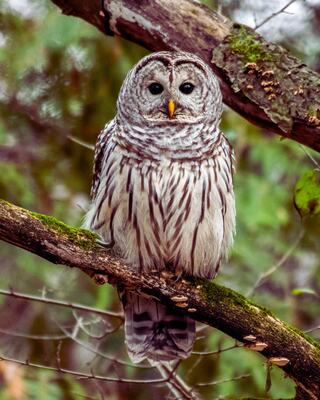
Barred Owl
Barred owls are beautiful, mysterious raptors known for their deep, hooting calls that echo through forests at dusk and night. Originally found throughout the eastern U.S. and Canada, they’ve slowly expanded westward over the past century.
With soft brown-and-white mottled feathers, dark brown eyes, and distinctive barring patterns across their chest and wings, barred owls are true masters of camouflage. Females are typically larger than males, and they’re skilled nighttime hunters—preying on squirrels, mice, chipmunks, birds, reptiles, amphibians, and even invertebrates. At the zoo, our barred owl enjoys a carefully prepared diet of bird-of-prey ground meat and mice.
Barred owls are an important indicator species for forest health, especially old-growth woodlands. They prefer large, hollow trees for nesting, which makes their presence a sign of a well-preserved habitat. Unfortunately, they’re also vulnerable to modern dangers—especially vehicle collisions, which are one of the leading causes of injury for these birds.
Say Hello to Choctaw
Our resident barred owl, Choctaw, came to the zoo as part of our raptor rehabilitation program after a serious injury. He became entangled in barbed wire, which led to the loss of the last digit on his left wing. Because of this injury, he can no longer survive in the wild.
Choctaw now lives comfortably in his barn habitat, serving as an ambassador for his species and helping guests learn more about raptors, forest conservation, and the importance of protecting native wildlife.